Tikva-Honig
Parnass – an Israeli anti-Zionist legend in her own lifetime
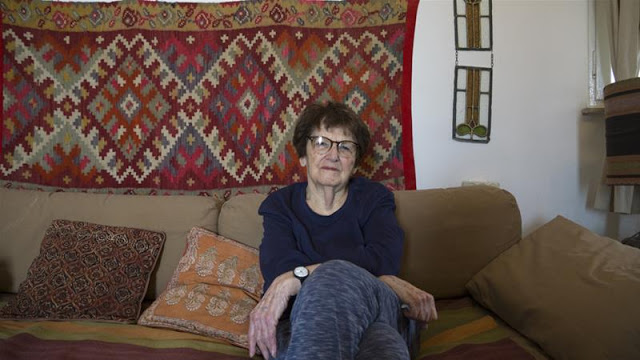 |
| Tikva Honig-Parnass’ Jewish militia played its part in depopulating and destroying Palestinian towns and villages in the 1940s [William Parry/Al Jazeera] |
I feel in awe writing this appreciation of one of the most dedicated
Jewish anti-Zionists to have remained in Israel.
Tikva Honig-Parnass was a
member of Matzpen, the Socialist Organisation in Israel, almost from its
inception in 1962. She was and is a Trotskyist, a member of the United
Secretariat of the Fourth International, though it is fair to say that her relationship
with the USFI and its Israeli representative Michel Warshawski has not been
an easy one.
Israel called its War of Independence but which the Palestinians know as the
Nakba, the Catastrophe, when over ¾ million Arabs were forcibly dispossessed
and driven out of Palestine. Even those
who remained were, to a large extent dispossessed and were described under the
1950 Absentee Property Law in the Orwellian phrase ‘Present-Absentees’, in other words although they were present in
the country they were still considered, from the purposes of land ownership as
absent.
served as the secretary of the left Zionist party Mapam (United Workers Party)
in the Knesset (1951–1954). It was a party that talked about socialism but
always prioritised Zionism, whose starting point was always what is good for
the Jews. In 1960 she broke with Zionism and joined the ranks of
“Matzpen.”
below the article in Al Jazeera is an interview by Leo Fischer in International
Socialist Review. Both are extremely interesting and well worth reading.
Greenstein
Honig-Parnass joined the Palmach militia as it ethnically cleansed Palestinians
and now works to expose the crime.
 |
| William Parry |
years ago, Tikva Honig-Parnass terminated her university classes, ignoring her
parents’ advice, and rushed off to join the Palmach, the elite Jewish military
force established in the 1940’s to help create a Jewish state in historical
Palestine. She was 18.
the Harel Brigade, played its part in depopulating and destroying Palestinian
towns and villages to create the foundations of the Zionist dream.
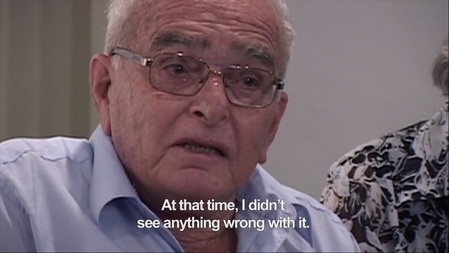 |
| Amnon Noiman’s testimony in the film On the Side of the Road talking about his role in the ethnic cleansing and massacres |
wireless operator with the Haganah, Tikva deserted her unit to join the Palmach
– “the crowning achievement of the Jewish Zionist youth” – and served
as secretary to the commander.
women in the Palmach “didn’t really take part in real combat” but they
followed close behind and witnessed the results.
around me were wiped out. Qalunya, just a few kilometres west of Jerusalem, was
on our right on the road from Jerusalem to Tel Aviv. One day it was wiped
out,” she says and is silent for several moments.
one of more than 500 Palestinian towns and villages that was ethnically
cleansed by Zionist militia during 1948-49. It was home to about 1,000 people.
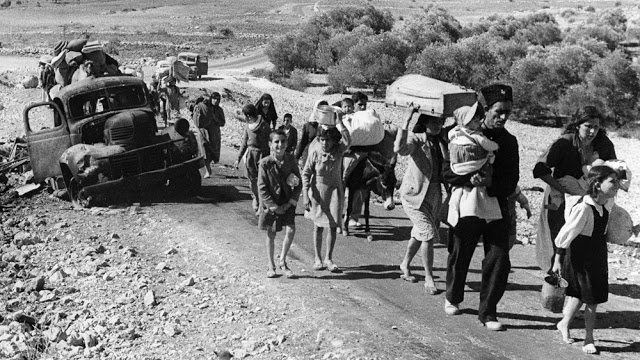 |
| Palestinian villagers expelled in the Nakba |
did they go to? How did they go? We never asked the questions,” she says.
if anything she witnessed shocked her, she answers: “Nothing. Nothing!
That’s the whole thing – nothing shocked us.”
indoctrination to the aims and self-righteousness of the Zionist enterprise was
evident from an early age. Her Zionist parents were as secular as they come,
she says, and she and her two siblings were enrolled in a secular Zionist
school – secular except that “we learned the Bible as an historical
document, six days a week”, says Tikva. (Her name means The Hope and is
the national anthem of Israel)
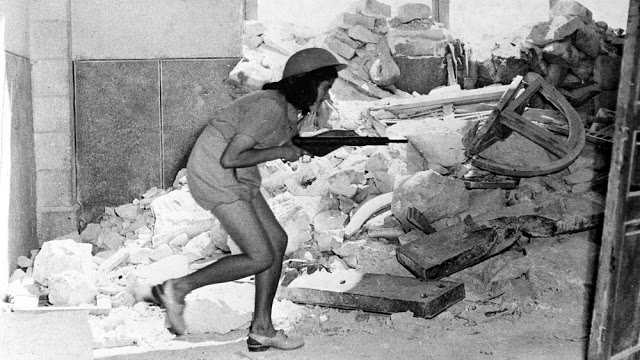 |
| A Jewish fighter armed with a Sten gun picks her way through the shattered walls of Suleiman’s Way, in the old city of Jerusalem, in 1948 [Jim Pringle/AP] |
89, Tikva is physically frail but mentally as sharp as nails, and her zeal and
determination remain. However, she has directed them for several decades now to
deconstructing and exposing via academic journals and articles the crimes on
which Israel’s foundations are built, and to analysing the psychological
mindset that was essential to indoctrinating the 1948 generation she belonged
to.
position we internalised [in the Palmach] pretended that we were not dealing
with the development of a military force that was waiting for an opportune time
to realise the Zionist plan for the conquest of the land and the dispossession
of its Palestinian inhabitants, but rather a ‘revolutionary army’ of the
oppressed,” she wrote in an article 20 years ago.
committed Marxist-Socialist who read Marx, Engels, Lenin, Plekhanov, Rosa
Luxembourg and others as a teenager, Tikva began to see Zionism as a
colonialist enterprise only in the early 1960s, particularly with the
establishment of the anti-Zionist political party, Matzpen, or the Socialist
Organisation in Israel.
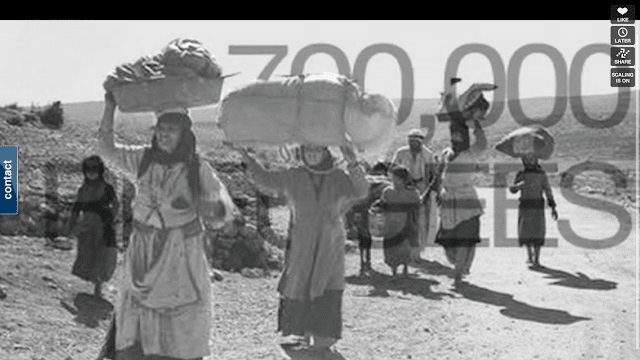 |
| Refugees stream from Palestine in 1948 [Jim Pringle/AP] |
this understanding, she notes: “I was still captive to the myths that
continued to be cultivated by Israel’s social and cultural elites … and above
all, to the comradeship in arms which was the emblem of the generation, and
which I still saw as an expression of supreme values.”
unexpected event in 1983 that took her journey to the next critical stage –
this time on an “emotional-experiential level”: in 1983 her mother
gave her letters that Tikva had written to her parents when she was young. One
of the first letters she read was dated October 30, 1948.
written on several sheets of paper that she had found in an abandoned petrol
station. The letterhead read in Arabic and English: “Ahmed N Sharabti,
Agent of the Shell Company, Bab Al-Wad Artouf Station, PO Box 712, Jerusalem,
Palestine.”
station was in a village that she used to retreat to for peace and space, she
recalls, wandering through the empty – emptied – Palestinian homes.
“Even
in the kitchens, there were things that people had left in their rush to flee.
I loved going to this village on my own, having it to myself. I often went
there in the evenings, during sunset. I never gave one thought to the people
who lived there.”
letterhead, Tikva notes with shock: “I had to have confronted the amber
words printed on the top of each page; indeed, I must have known that here was
a man who lived and worked, and was expelled or forced to flee by all my
glorious brothers in the unit in which I served?“
just wiped it the entire memory from my mind, I erased it,” she says.
“And then it all came back to me when I read that letter.”
to dehumanise their victims was consummate, she says.
mentions in the letter many Palestinian women and children whom they had
displaced, “starving for bread”. Their suffering didn’t trouble her
at all – but what did were several American Zionists with them who were openly
critical of their comrades’ disregard.
“The
letter uncovers an advanced stage in the dehumanisation process and the
emotional crippling that my generation had to undergo in order to fulfil the
missions which were assigned to them: conquering the land, expelling its
indigenous Palestinian residents, expropriating most of their lands and turning
them into ‘state lands.'”
individual human rights were subsumed by the collective rights of the Zionist
state, she says.
“I was
brought up where the individual didn’t have any rights – it wasn’t said
explicitly but it was confirmed indirectly by the collective and the state as
its expression. It’s this idea of putting the security of the state over
individual human rights – everything is defended and justified as the
‘security’ of the state.”
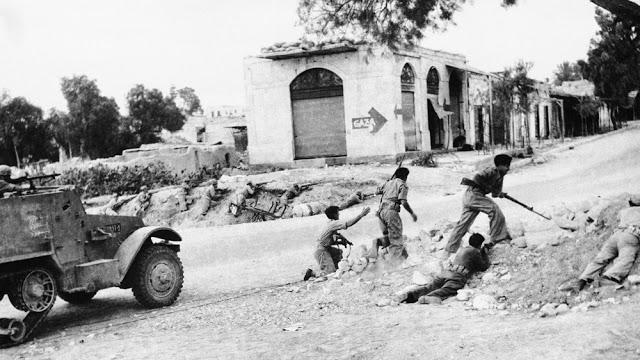 |
| A detachment of Jewish soldiers attacks a small village in the Negev area in 1949 [AP] |
little difference with the ‘semi-fascist indoctrination’ that shaped her as a
child with the prevalent views that shape Jewish Israelis today – myths that
remain essential for Israel to justify its dispossession and human rights
violations, and to survive as a Zionist state, she says.
of apartheid inside Israel and exercised in the occupied territories; the
blockade of Gaza and the military force used against an imprisoned population;
the extrajudicial killings – it’s all an essential extension of Israel’s
founding ideology, she believes.
“The
argument is that it’s not only about security but existence. It is an
existential war, they want to eliminate us. You see the absurdity of the whole
scene? I don’t think any colonialist movement in the world, not even South
Africa, succeeded in turning upside down this logic, of making the colonisers
the victims.”
to “de-colonise” her mind has taken decades. It has resulted in
alienation from her community but acceptance from Palestinians and fellow
internationalists, as she sees herself.
bleak picture at home, describing the “Daesh-isation” of Israel as it
becomes more religiously extreme, and its moves to becoming a “typical
fascist state”.
the boycott, divestment and sanctions (BDS) movement and some
“self-contradictions within the Jewish community” as the few signs of
hope that help keep her going. And her filmmaker grandson, she adds proudly, whose
values confront and challenge those of his society.
there’s no future for him here with his thinking,” she notes with
acceptance.
Jazeera
the Wall: the art of resistance in Palestine, and co-director and co-producer
of a short documentary, Breaking the Generations: Palestinian prisoners and
medical rights.
Apartheid Israel and the contradictions of left Zionism
Honig-Parnass fought in the 1948 War as a Zionist. Years later she would break
with Zionism and join the ranks of the Israeli Socialist Organization, also
known by the name of its publication, Matzpen (“Compass”).
Marxist anti-Zionist group that was active in Israel during the 1960s and
1970s. The group called for the solution of the Israeli-Palestinian conflict in
a regional framework that would involve the unification of the Arab East under
a socialist and democratic banner, while also granting Palestinian Arabs and
Israeli Jews equal individual, as well as equal collective, national rights.
Matzpen exists today as a network of individuals in Israel and abroad. Its
theory and analysis can be found on the Web.
sociology from Duke University in the United States, Honig-Parnass returned to
Israel where she is active in various movements, including those against
Israeli occupation of Palestinian lands, for Mizrahim (Middle Eastern Jews),
and for feminism. Along with Palestinian activist Toufic Haddad, she co-edited
the journal Between The Lines, and later they wrote a book entitled Between
the Lines: Readings on Israel, The Palestinians and the U.S. “War On Terror”.
She is currently working on a new book about the Zionist left.
Carpet Institute interviewed Honig-Parnass in her Jerusalem home on March 4,
2010. The interview is reprinted with permission.
committed Zionist and a veteran of the 1948 War. Could you give a description
of the factors that convinced you to break with Zionist ideology?
nature of my breaking away from Zionism, I have to emphasize that I crossed
over to anti-Zionism from the camp of the Zionist left, and even the Zionist
far left—the “Marxist” party of Mapam (an acronym for the Unified Workers
Party), which called for “Zionism, socialism, and fraternity among nations”
without seeing the inherent contradiction within this slogan.
was also the secretary of the party in the Knesset between 1952 and 1955,
agreeing fully with its hypocritical stance reflected in its calling for
socialism on the one hand, and participating in the great theft of the lands of
the Palestinians who remained within the borders of Israel after 1948—while
they were living under military rule (between 1948 and 1966)—on the other.
Israel was initially founded as a socialist-inspired state since Mapai, the
Israeli equivalent to the German Social Democratic Party or the British Labor
Party, was instrumental in creating the state’s institutions. How was that
possible in a capitalist framework?
by Mapai, led the Zionist colonial project in Palestine during the pre-1948
period. Its political, economic, and ideological hegemony was the product of a
kind of division of labor between it and the embryonic Israeli bourgeoisie. I
won’t go into the reasons for this agreed-upon division (they are
systematically elaborated by Professor Zeev Sternhell in his book Nation
Building or a New Society? The Zionist Labor Movement (1914–1940). It is
sufficient to say that the weak emerging bourgeoisie conferred the political hegemony
to the Zionist Labor movement, which was responsible for retaining the
“industrial quietness” it needed, while collectively building the political and
economic infrastructure for the future state.
here, because it has implications for the present, is the role that left
Zionist intellectuals, academics, and publicists had—and still have today—in
articulating the main narrative of Zionism and legitimizing the Zionist
colonial project. Claiming to possess the “scientific“ or the moral authority,
they have justified the most terrible violations of human rights committed by
all Israeli governments—left and right alike. The pre-state Zionist Labor
movement created the false theory of “constructive socialism,” which was a local
version of nationalist socialism. It called for the collaboration of labor and
bourgeoisie—the “productive forces of society”—which contribute to the
“collective” interests of state and society. This theory and ideology was
easily established after 1948 as the “state-centered” system of values that
lies at the center of Israeli society’s culture until this day. What we are
dealing with here is an ideology that sees the state and its “security” as the
most important value, having priority over any individual interests.
Israeli culture—a semi-fascist culture, as described by late critical
sociologist Baruch Kimmerling. It admires what left Zionist social scientists
from the functionalist-structuralist school, led in the first decades of the
state by S.N. Eisenstadt, liked to call the “collective goals” of society.
These imagined “collective” goals were pointed out as a justification to subdue
individual aspirations and rights that, in an apparent contradiction to any
liberal-democratic tradition, are regarded as “egoistic.”
exclusive rule ended years ago. Isn’t all of this a thing of the past now?
Labor in 1977 and the ascent to power of the right-wing Likud didn’t lead to an
end of the hegemonical status of the ideology and narrative composed by the
Zionist left. There was no change in the widely accepted image of Zionist left
intellectuals, academics, publicists, and writers like Amos Oz as the
representatives of consciousness, justice, and equality. The latter, however,
continued to legitimize every atrocity and every war that Israeli governments,
whether left or right, have launched against the Palestinians or neighboring
Arab countries. At the same time, however, they supported the peace plans
initiated by Zionist left leaders, whose vision of a two-state solution ensured
the continuity of Israeli rule on a fragmented Palestinian Bantustan.
and political principles of the Zionist left continues to this day, because it
continued to constitute the various elite groups like the Israeli academy, the
legal system, the government bureaucracy, as well as public and national
institutions. This hegemony reaches as far as the directors of economic enterprises
in the private sector and even the capitalist class itself. Here lies what
seems like a contradiction: The Israeli capitalist class has in the last
decades supported the Labor governments, which in turn represented its
interests. Indeed, it was the Labor government that introduced economic
neoliberalism in 1985 as part of a U.S. plan for a globalized economy and
military dominance in the Middle East. And, of course, the Israeli capitalist
class adopted the U.S.-Israeli peace plans since the Oslo Agreements in 1993,
which have been perceived as a necessary condition for the survival of imperial
interests in the region.
between left and right about the central premises of Zionism. As emphasized by
historian Avi Shlaim, the only difference between Ben Gurion, the leader of the
Zionist Labor movement, and Jabotinsky, the forefather of the right-wing Herut
and Likud, was in the sequence of the stages that the project of an exclusivist
Jewish state in the entire area of historical Palestine had to take in order to
achieve its aims.
gradual wiping out of the traditional secondary differences that existed
between right and left. Kadima and Likud have adopted the “pragmatism” of the
Zionist left, as well as its hypocritical discourse relating to the “peace
process.” Beginning with Ariel Sharon, who won the elections in 2001, right and
center have declared their adoption in principle of the concept of “dividing
the land” and of the “two-state solution”—previously the position of the
Zionist Left alone. No wonder Labor can participate in the present ruling Likud
coalition alongside the racist Ivet [Avigdor] Lieberman, the chair of Israel
Beitenu—the most extreme secular right-wing party—which calls for the
“transfer,” i.e., the expulsion of the Palestinian citizens of Israel. The wide
adoption of Labor positions, however, signifies a rather pyrrhic victory for
the Zionist left, since due to this success it lost its rationale for a
distinct political existence and has become an altogether irrelevant political
force today.
impact of left Zionism on you and at what point did you begin to challenge this
ideology?
pre-1948 generation, that is, someone who was committed blindly to the dominant
Zionist left discourse, namely, “our” historical right to “return” from exile
to the entire “land of Israel” and to regain its sovereignty in an exclusivist
Jewish state. In my youth prior to 1948, I had read all of the Marxist
literature published in Hebrew and never saw any contradiction between it and
my own Zionist position. For my generation, the Palestinians were considered a
kind of nuisance that should be removed from the way leading to the foundation of
the Jewish state. This self-dehumanization, as well as the dehumanization of
the Palestinians, prepared us for accepting the 1948 mass expulsion of the
Palestinian people that was committed under the leadership of the Zionist Labor
movement—Mapai and Mapam. The glorification of the concept of a Jewish state
permitted the prevailing indifference of my generation in taking part in the
1948 ethnic cleansing without any emotion or doubt.
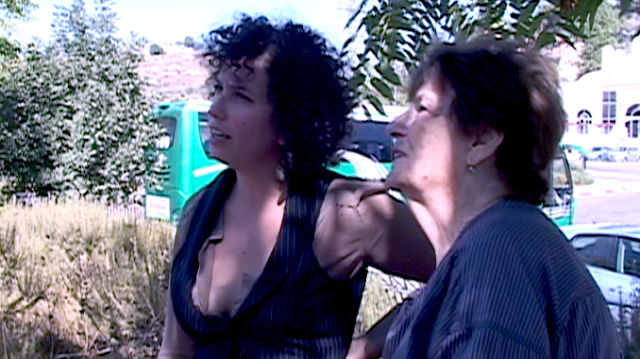 |
| Lia Tarachansky and Tikva Honig Parnass on the site of Saris in On the Side of the Road |
difference between Zionist left semi-fascist statism on the one hand, and real
liberalism on the other, I will give you a short story. I served in the Palmach
unit, which conquered the area that included the Palestinian villages of Saris,
Beit Jibrin, and Zakariya among others, and expelled their residents. I have a
letter I wrote to my parents in October 1948, which was written on the
stationery of the Palestinian owner of the Har Tuv gas station, who was
expelled just a few days before. Typically, however, I don’t even reflect on
this fact.
Jewish-American volunteers, liberal Zionists, who had not been brought up in
the ideology of the Zionist Labor movement. They were among many American
Jewish veterans of the Second World War who came to support the Yishuv (the pre-1948
Jewish community in Palestine) military forces in the 1948 War. One evening,
they came from a mission shouting that they met on their way back to the base
Palestinian women and children starving to death and begging to go back to
their villages. They added angrily that, “if this new state cannot take care of
its Palestinian inhabitants, then it has no right to exist.” And me, a left
Zionist, who claimed to be a Marxist and an internationalist wrote: “Dear
mother and father, I’m sick and tired of these American ‘philanthropists.’”
Notice that I used the expression “philanthropists” rather than “humanists.” So
this is just an example of the difference between liberalism, universalism, and
internationalism on the one hand, and Zionist “left” values on the other.
Hebrew University in Jerusalem to continue my studies. I remember being in a
student hall one day when someone burst into it saying that Mao Zedong had
proclaimed the People’s Republic of China. We were cheering and clapping at the
news, while at the same time a military government was being imposed on the
Palestinians who remained after the 1948 War under Israeli rule and their lands
and property were being confiscated. At the same time those who were expelled
and attempted to cross the border back to their homes were shot by the Israeli
security forces.
issues of Israel and the Middle East had even been strengthened when I quit my
post as secretary of Mapam in the Knesset and moved closer to the Communist
Party. Accordingly, I continued justifying the UN partition plan and the
founding of the Jewish state, which was supported by the Soviet Union, and
whose satellite, the Communist Party of Israel, had signed the Declaration of
Independence.
book Peace, Peace And No Peace, written by Akiva Orr and Moshe
Machover, came out. Without access to any official files, which were released
over two decades later, and basing their study only on information published in
newspapers and professional magazines alone, they succeeded in proving that
Israel was indifferent to the will of Arab states to make peace with it and
systematically ignored their peace proposals. This was a big shock for me,
since the very idea that the state of Israel refused to make peace was
unthinkable, especially when the ruling propaganda depicted the Arab states as
aspiring to destroy Israel.
reject the prevailing misleading discourse spread by the establishment. This
was the first doubt that appeared in my mind, shaking my firm belief in a
peaceful Israel, and preparing me to accept wholeheartedly Matzpen’s political
position when it was founded in 1962 by a group of about fifteen people headed
by its four initiators, among them were Moshe Machover and Akiva Orr.
kind of revelation for me. It wiped out all the misleading beliefs, which until
then had been part and parcel of my being and self- identity. I learned that
Israel was a colonial-settler state—a vehicle for implementing and advancing
the Zionist project, which—long before the 1948 Nakba [Arabic for
catastrophe]—aimed at the expulsion of the indigenous residents of Palestine. I
accepted the regional perspective of Matzpen, which emphasizes Israel’s role as
the enforcer of imperialist interests in the Middle East, and which places the
ultimate resolution of the conflict outside the Palestine box.
between Marxism, class analysis, anti-imperialism, and anti-Zionism has never
before—and never again—existed among the Israeli left. The Communist Party,
despite its non-Zionism, failed to draw the connection of the first three
elements with the last. It had signed the Declaration of Independence in 1948
and saw the alliance of Israel with imperialism as somehow a matter of choice
rather than a central characteristic of Zionism and the state of Israel. Until
this day, the Communist Party has not put the challenge of the Jewish state at
the center of its agenda. It has focused its struggle on achieving equal
citizenship and individual rights for Palestinian citizens, rather than that
for national collective rights that the Jewish Zionist state does not and
cannot recognize.
degree of significant influence in Israel? What is the status of Jewish (i.e.,
non-Palestinian) anti-Zionism inside Israel today?
come out against the 1967 War, and was at the forefront of the protest movement
against the occupation that spread in the first years after the war. This
gained Matzpen support among a rather substantial number of young people. Part
of this support was then due to the impact of the 1968 student uprising in
Europe and the civil rights movement in the United States. Matzpen’s political
positions were seen as the right translation of these uprisings to the local
version of the oppression of the Palestinians. However, the adoption of the
comprehensive anti-Zionist and class-based perspective of Matzpen has been
rather limited.
Matzpen was on the militant uprising of the Mizrahim (Jews from Middle Eastern
countries) Black Panthers, which took place between 1970 and 1972. They were
second-generation Jews from the Arab countries who had been brought to Israel
in order to fulfill the urgent need of the newly born state to settle the
“empty” occupied territories the Palestinians had been expelled from, as well
as to increase the numbers of the Israeli army. The Mizrahi immigrants were in
fact dumped in places without any real economic planning or productive
employment, thus creating the “development towns” which subsequently would
become the most neglected Jewish communities in the country. “Emptied”
neighborhoods in originally Palestinian or “mixed” towns, were also resettled
with Mizrahi newcomers, which soon enough turned into pockets of poverty as
well.
Matzpen, a young group of Mizrahi Jews in an ex-Palestinian neighborhood on the
outskirts of Jerusalem, Musrara, began to articulate their rage against their
systematic discrimination by the Zionist establishment in class terms. Matzpen
formed not only their ideological perspective, but also provided them with
logistical support. This was truly a movement with massive potential. But they
were crushed by the authorities, who jailed their leaders and activists and
harshly persecuted them after their release from prison. Moreover, the Black
Panthers’ anti-Zionist and anti-capitalist message was twisted since then by identity
and culturalist-oriented Mizrahi activists and post-Zionist academics.
intellectuals since the mid-1990s, Matzpen stood out as a role model. Since
then, some of the critical among them (post-Zionist sociologists like Uri Ram
and Yehuda Shenhav) made sure to pay homage to Matzpen as the first to depict
Zionism as a colonialist movement. However, by taking Zionist colonialism out
of the anti-imperialist framework and the class analysis of Matzpen, they
entirely distorted its approach and failed to create any alternative to Zionist
ideology and praxis. Thus the full impact of Matzpen has been materialized
mainly among genuine anti-colonialists, socialists, or democrats, both in
Israel and abroad, who are willing to apply its principles for a full rejection
of Israel as a Zionist state.
anti-Zionists are considered by left Zionist intellectuals, as well as by wide
strata in Israel, as traitors who challenge the very existence of the state.
The discourse around this issue blurs and confuses the idea of the physical
existence of the Jewish citizens of this state with that of its existence as a
“Jewish state.” Moreover, the Jewish identity of Israel has become synonymous
with the notion of its “security” and thus further deepens the commitment of
most progressive Israelis to its racist nature as well.
about post-Zionism. What are, in your opinion, its strengths and/or
limitations?
the school of new historians and critical sociologists on the one hand, and
those I depict as post-Zionists on the other. The first group refuted some
basic narratives of Zionism regarding the 1948 War and the Nakba, but without
challenging the very nature of the Jewish state as an ethnocratic,
colonial-settler state (Ilan Pappé is an exception). On the other hand, the
post-Zionists had the intention to disclose and refute Israel’s assumed
structural inequality as reflected in the discrimination of its Palestinian
citizens, as well as other Jewish “minority groups.” Their theoretical base,
however, was postmodernism and its related fields—multiculturalism,
postcolonialism, and identity politics—which they have wrongly used for their
analysis of the Zionist state.
equate the oppression of the Palestinians with that of the Mizrahim, perceiving
both as the victims of the Ashkenazi (European Jewish) Zionist state. They thus
ignore the central feature of Zionism which implies the full exclusion of the Palestinians
from the exclusivist Jewish state, while the class-based oppression of Mizrahi
Jews does not stem from the colonial character of the state of Israel, whose
main dividing line is that between Jews and Palestinians. In fact, their
“multiculturalism” and politics of identity brought many post-Zionists to turn
their backs on the strengthened Palestinian and Arab nationalism among the
Palestinian citizens and their demands, which are far away and even
contradictory to the quest for recognizing their “minority group identity.”
concentrated on a thorough analysis of Israel as a colonial-settler state. They
have not been anticapitalist or anti-imperialist, as they never challenge
economic neoliberalism or Israel’s role in serving U.S. interests in the
region.
your opinion, a radicalization or an erosion of Zionist ideology?
and implementation in policies and laws, has enormously radicalized. When its
false self-identity as a peaceful state is being crushed on a daily basis,
there is a need to strengthen the commitment of the people to Zionism.
Zionism is the overt confirmation of Matzpen’s thesis about the regional nature
of the Israeli-Palestinian conflict. The U.S.-Israeli quest for hegemony in the
Middle East and the “war against terror,” aimed at subduing “disobedient”
states like Iran and Syria, and crushing Islamic resistance movements like
Hezbollah and Hamas, are at the center of public discourse. The establishment,
supported by wide strata—including the Zionist left—has been involved in a
determined effort to describe this war as a necessary condition for the
survival of the Zionist Jewish state.
awareness of the role that Zionism plays in harnessing Israelis to support its
war policy, is the opening lecture by Benjamin Netanyahu in the last annual
Herzliya conference that gathers Israel’s political, economic, and military
elites for discussing the most urgent topics that are included in the present
agenda of the state. Netanyahu’s lecture focused on the exclusive Jewish right
to all of the land of Israel, i.e., historical Palestine, and the need to
strengthen the citizens’ Zionist consciousness.
from my own experience: Last year, I went to a ceremony at my grandson’s school
in northern Tel Aviv, a known bourgeois, secular, and liberal area, where most
people vote for “left” Zionist parties—Labor or Meretz. It was a commemoration
day for all fallen Israeli soldiers, where all the pupils and their parents, as
well as the bereaved families, were present. The event was opened when a boy
wearing a kippa [Jewish skullcap]—in a supposedly secular school—read from the
Bible that God said to Abraham, “Look from the place you are there, to the
north and south and east and west, because all the land you see, I will give to
you and your offspring until eternity.” This scene just shows the strengthened
tendency in education to deepen the commitment to Zionism and the aggressive
war policies of the state of Israel. To open the memorial day with this promise
of God to Abraham is a message given to the children that you must fight
fiercely in the future inevitable wars against the Palestinians and others
because this land, which is exclusively ours, is in danger.
“the only democracy in the Middle East” and the civil rights enjoyed by
Israel’s Palestinians are indicated as a proof of this. What is the situation of
Israel’s Palestinian citizens?
now all historical Palestine—from the Mediterranean to the Jordan River. Israel
has settled half a million of its own citizens there; it has extended its own
laws there and uses aquifers and airspace there every single day. In practice,
Israel has annexed the West Bank without officially declaring it. Many among
the left Zionists adhere to the misleading claim that the West Bank (and Gaza)
are exterior to the state of Israel and that the 1967 occupation is only
temporary and eventually these areas will constitute the independent
Palestinian state. They thus conceal the fact that these areas have in fact
been annexed and are part and parcel of Greater Israel—something that allows
them to retain the image of Israel as “the only democracy in the Middle East.”
government on different parts of Palestine in different historical stages.
Hence the different levels of civil rights and civil status of the Palestinian
inhabitants of these parts—from no civil rights in the West Bank and Gaza, to
formal citizenship granted to the remaining Palestinians after the Nakba of
1948, something that was a condition imposed on Israel in order to be accepted
as a member of the United Nations.
Israel’s democracy must include both the obvious and observable apartheid
regime in the 1967 Occupied Territories—to which the left abroad is willing to
admit—and the somewhat masked apartheid within the Green Line (“Israel Proper”),
which they are reluctant to depict as such and still regard as a democracy.
exaggerated? The Palestinians in Israel are after all able to vote for their
representatives in the Knesset.
Matzpen’s thesis, which was elaborated by Moshe Machover, regarding one
essential difference between the Israeli version of apartheid and that which
prevailed in South Africa. Accordingly, Zionism, like the North American or
Australian species of colonization, aimed at eliminating the native population
instead of keeping them as a reserve of cheap labor power. Unlike the Blacks in
apartheid South Africa, Palestinians were considered dispensable, which
explains the notion of mass expulsion looming in Zionist thinking long before
1948. This “solution” is still adopted by Israeli political and intellectual
elites, as explicitly expressed by historian Benny Morris. However, until the
right circumstances appear, a consistent policy of ethnic cleansing in slow
motion—physical, political, and social—has been taking place all over historic
Palestine, albeit with different methods and levels; by disconnecting
Palestinians from their cultivated lands, banning their access to basic
resources of livelihood, not to mention the devastation and massacres which
took place in Jenin and Gaza.
structural discrimination against the Palestinian citizens qualify Israel as an
apartheid regime that is similar to that of South Africa, albeit, as said,
intentionally camouflaged. Unlike apartheid in South Africa, which openly
declared its racism in all walks of life, what we have seen until recently in
Israel is a kind of racism that avoids any racist language that explicitly
points to the discrimination against Palestinians. The legal, political, and
ideological infrastructure of this form of apartheid regime was laid down
during the first decade of the state by Zionist Labor governments in which the
“Marxist” party of Mapam was a senior member.
article, every single major South African apartheid law has a direct equivalent
in Israel today. For example, the Population Registration Act of 1950 assigned
to every South African a racial identity according to which each of them was
entitled to (or was denied) a different set of rights. This has a direct
equivalent in the Israeli laws that assign to Jews and Palestinians a distinct
national identity. According to Israeli law, there is no such thing as Israeli
nationality. The only nationality Israeli law recognizes is the Jewish
nationality, which encompasses Jews all over the world and for whom Israel
claims to be their state. Non-Jews, although they can be citizens of the state,
are explicitly not members of an Israeli “nation.”
are recognized as having a national identity, Israeli law strips Palestinian
citizens of their national identity and reduces them to a mere ethnic minority,
the “Israeli Arabs.” This in itself is the backbone of the discriminatory regime,
even before any statement is made about discrimination. In Israel, various
fundamental rights—access to land and housing, for example—are dependent upon
national identity, not the lesser category of mere citizenship.
determine access to land inside Israel exemplifies a wide range of these
rights. They constitute a direct equivalent to the South African Group Areas
Act of 1950, which assigned different areas of South Africa for the residential
use by different racial groups. Palestinian citizens are legally excluded from
residing in officially designated “Jewish community settlements.” Moreover,
they are barred from living on state land or land held by “national
institutions” such as the Jewish National Fund (JNF), which comprises 90
percent of lands in Israel—most of which had been confiscated from
Palestinians. These institutions openly claim that they are “the caretaker of
the land of Israel on behalf of its owners, Jewish people everywhere.”
to the Palestinians who survived the Nakba in 1948 is systematically stripped
of any solid guarantee for political and individual rights. Thus, for example,
political parties and individuals, if they don’t recognize the Jewish state,
and even use the right to challenge it by democratic means, are seen by the
Shabak (the internal security service) as a security threat to the existence of
Israel and risk being barred from participating in the elections for the
Knesset. The right to citizenship or even residency is denied to a Palestinian
spouse from the 1967 Occupied Territories or other Arab states.
conflict is a highly divisive issue among the German left. Some leftists have
come to the conclusion, given the shift in the region for Islamic movements
like Hamas and Hezbollah (and the subsequent weakening of the secular
nationalists and the left) that supporting Israel’s “right to exist ” is a
necessary step to defeat “reactionary” or “medieval anti-Semitic” tendencies.
What is your response to that?
contradicts any aim related to a progressive secular democracy. Precisely this
discourse has served as the pretext for the “war on terror” that U.S.
imperialism has been fighting in Iraq and Afghanistan, as well as the
U.S.-Israeli wars in Lebanon and the bloody assault on Gaza in 2008–09.
Therefore, those on the left who believe in fighting for “Israel’s right to
exist” should realize that this implies joining the war against the new demon
that U.S. imperialism has created after the fall of the Soviet Union. That is,
using “Islamic fundamentalism” as a pretext to crush the resistant forces in
the Middle East, be they secular or religious—all this in the name of “secular
democracy.”
right of U.S. imperialism to consolidate its political, military, and economic
rule in the Middle East. You cannot separate Israel as the tool for advancing
the Zionist colonial project and its apartheid regime from its role as the
enforcer of U.S. imperialist interests in the Middle East. Israel is the one
solid, reliable supporter of the United States, its very own armed watchdog
against any state or movement that challenges U.S. imperial interests in the
region. As such, its total war against the Palestinians is part and parcel of
U.S. strategy to abolish any call for genuine national independence.
anti-imperialist struggle in the region has not been led by left forces.
However, the left should recognize that Hezbollah and Hamas are by now the only
organized forces that fight against Zionist Israel, the United States, and the
collaborative Palestinian and Arab leaderships. Hezbollah plays the most
genuine role in fighting for the national independence of Lebanon. If not for
Hezbollah, Lebanon would be ruled by now by the Lebanese fascist
Phalange—indeed “secular”—in collaboration with Israel and the United States.
the most democratic general elections. The joint American, Israeli, and Palestinian
Authority total war against Hamas is in fact a war of ethnic cleansing against
the entire population of Gaza. This is the nature of the war, cynically claimed
to be waged for the “right of the state of Israel to exist.” Therefore, the
position of some in the German left regarding Islamist movements like Hezbollah
and Hamas is in fact nothing else but a call to support the U.S.-Israeli
efforts to intensify the fragmentation of the people throughout the Middle
East. In this case, to prevent the reunification of Gaza and the West Bank, to
which Hamas aspires, and to delegitimize Hezbollah and its integration into the
Lebanese political system. The right of Israel to exist is in fact the right of
the Zionist apartheid state to continue its project of eliminating the
Palestinian people and subduing the Arab nations in the service of Western
hegemony over the region.
left Zionist academic Zeev Sternhell regarding the alleged rise in European
antisemitism contradicts the prevailing rhetoric about a “medieval
antisemitism” relating to Islamic movements:
reported a dramatic rise in events defined as antisemitic during “Cast Lead”
[in Gaza]. It is doubtful if the motives to all, or even to most of these
events were antisemitic. It stands to reason that regarding part of them, we
are witness to escalating anti-Israeli [attitudes]. Past antisemitism was not
dependent upon the objective deeds of Jews. On the other hand, there is a clear
and consistent connection between hostility to Israel and the deed it commits.
It is not by chance that anti-Israeliness is a phenomenon which appeared in the
last generation: It is a reaction to the deepened occupation [of the 1967
territories].